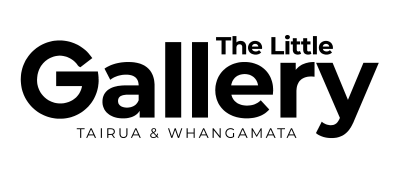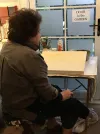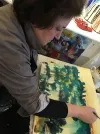Art Creation with Paula McNeill
- 1 June 2016
- Sarah Holden
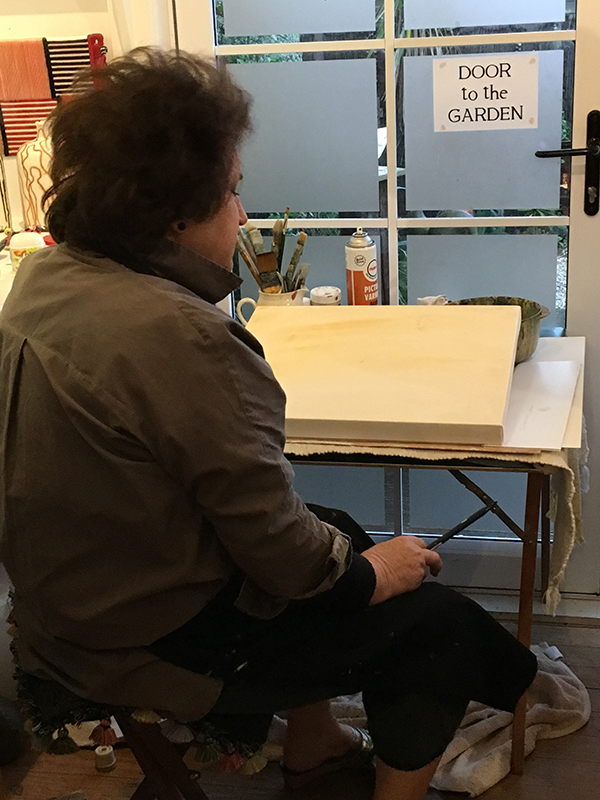 Despite the rain outside we still had a lovely group join us for our discussion on Art Creation, led by artist and gallery curator Paula McNeill. This was an opportunity to watch her process as she worked on a painting from the first defining stroke through to the finished product.
Despite the rain outside we still had a lovely group join us for our discussion on Art Creation, led by artist and gallery curator Paula McNeill. This was an opportunity to watch her process as she worked on a painting from the first defining stroke through to the finished product.
Paula sat in the corner with the group watching on and decided if she wanted to create a horizontal or portrait work. She was inspired to create a landscape and so set the canvas horizontally across her table.
She took inspiration from a piece of work nearby and discussed that she gains inspiration from a number of different sources including:
- dreams
- emotional, heart driven
- events
- surroundings
- other work
Paula had already prepared her canvas with a seal and light wash to take away the ‘bright white’ blankness of the canvas. She then looked at the basic structure and described the ‘golden slice’, which is basically where you imagine a centered cross on the canvas and discussed how you should avoid something dominant on those lines.
Where do you start?
Paula chose the top right quarter section to create one focal point and the idea is that you build the painting to draw the viewer’s attention to the focal point. You should ‘walk’ the viewer through the painting, creating a journey to reach the focus. If you had numerous points the viewer would get distracted and confused and not know where to look. The artist creates the pathway by using shapes and a balance of colour.
Paula outlined hill ranges on horizontal thirds, in a light-pressured colour so that it didn’t interfere with any other colours she wanted to add. She worked at making the shapes interesting and undulating, and avoided it being boring by extending lines and adding layers. This is her artistic license to give you an impression of the hills without them being exactly as they are seen. She also ensures that she echoes shapes without it being too obvious which helps to travel someone through the work.
Colour Palette
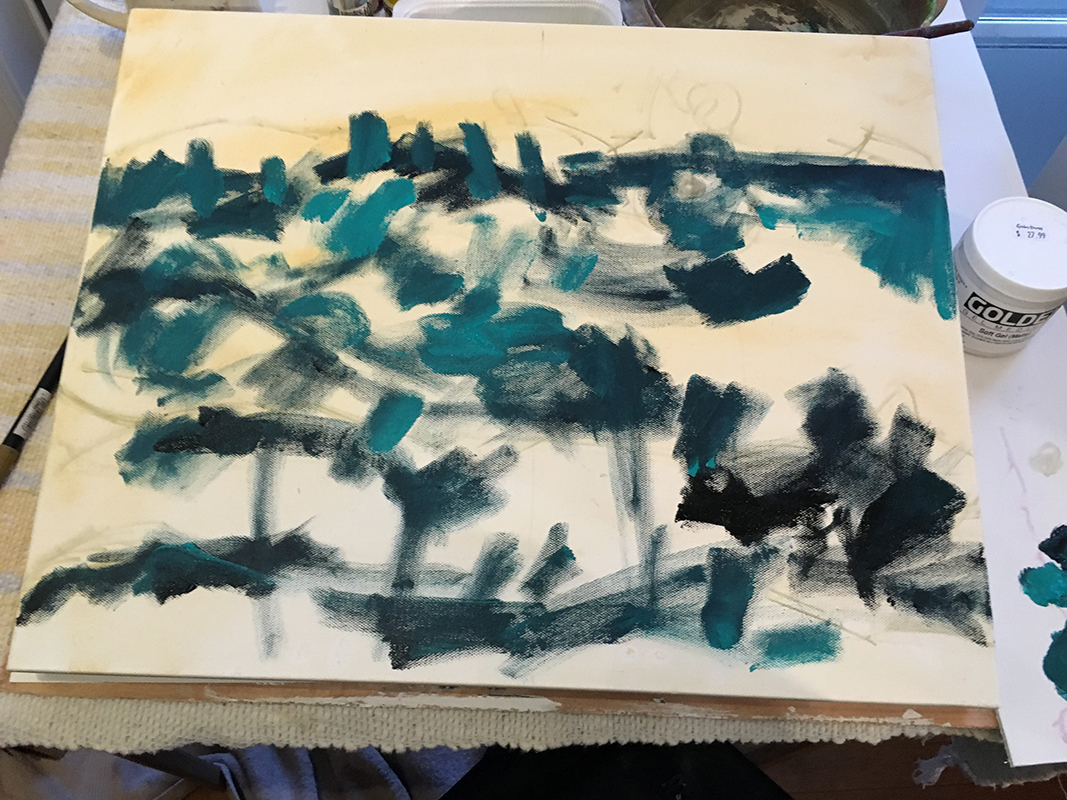 Paula took the time to consider the colours and hues of her painting and started with a blue/black, which is softer than a straight black colour, and is easy to mix with and avoid creating mud. She commented that as an artist you work from dark to lights (which are used to make things stand out). She uses an initial colour as a mixer to build a family of hues that reflect and repeat the colour. You then repeat the colours to move your eyes through the work, e.g. she used magenta as a shadow as well as a roof. Paula warned us not to leave a colour isolated as it can be detracting. She repeated the colour in the same way as she did with the shapes to lead the viewer on a journey. This is where Paula’s artistic ability starts coming to the fore as she has the confidence to build on the painting with practiced strokes and purposeful movements across the work.
Paula took the time to consider the colours and hues of her painting and started with a blue/black, which is softer than a straight black colour, and is easy to mix with and avoid creating mud. She commented that as an artist you work from dark to lights (which are used to make things stand out). She uses an initial colour as a mixer to build a family of hues that reflect and repeat the colour. You then repeat the colours to move your eyes through the work, e.g. she used magenta as a shadow as well as a roof. Paula warned us not to leave a colour isolated as it can be detracting. She repeated the colour in the same way as she did with the shapes to lead the viewer on a journey. This is where Paula’s artistic ability starts coming to the fore as she has the confidence to build on the painting with practiced strokes and purposeful movements across the work.
She then works in the complimentary colour, which is orange/yellow, and begins to discuss the temperature of the colours. She talks about two different yellows and how one can be cold and one warm and how the different temperatures create interest in the painting and allowed her to make a recessed skyline and then repeating the colours in the foreground to highlight points on the viewer’s journey.
Each new colour is added to a board beside Paula, which she uses to test the colour to ensure that it is the right hue and provides the right balance against the other colours in the family. Paula likes to have fun with colour and uses it to highlight the focal point that she first created at the beginning of the process.
Paula gives away some master tips, one of which is not to over-mix the paint, and ensure you do it whilst it is still wet. This will mean that each colour that is incorporated is given some space on the canvas and allows you to build on the work without the colours turning muddy. The paint is applied thinly and then built upon to create depth with a thicker coat.
Brush Strokes
Paula used a variety of brushes and it was noted that she just kept them in the same water, not afraid to clean them in the same pot. As she used only a limited colour palate all the colours complimented each other anyway so she wasn’t afraid to allow them to blend together.
She used her brushes to play with parts that were too dominant and therefore were detracting from the focal point, at one stage lifting off the paint with a rag. This allowed her to experiment with the painting and break up heavy areas.
Questioning the work
 Paula takes a breather and allows the work to sit and take it in and asks herself:
Paula takes a breather and allows the work to sit and take it in and asks herself:
- Does it work?
- What would work?
- What colours should I use?
Don’t be afraid to explore and enjoy the moment – enjoy the process and celebrate the exciting parts! But be mindful to remain sensitive to the works composition and colour choices. Subtle changes made by colour or brush strokes can have a huge impact.
It was extremely insightful to glean some tips from an artist’s perspective as well as entertaining and mesmerizing to watch her work. What do you think of the painting she created in just under an hour? Donna Brook, from Sunlover B&B, was the lucky winner and once it has been dried and set then she will get a chance to put it up in her home. She told me she already knows exactly where she wants to put it!
Artist Liz Hart will lead our next art creation talk on Sunday 26 June at 4pm. Make sure you pop in to watch the process of this very different artist!
